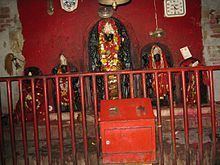Area 3,706 km² | Website Official website | |
 | ||
Administrative division | ||
Jharkhand s chatra district left isolated
Chatra district (Hindi: चतरा जिला) is one of the twenty-four districts of Jharkhand state, India, and Chatra is the administrative headquarters of this district. The district covers an area of 3706 km². It has a population of 790,680 (Census 2001).
Contents
- Jharkhand s chatra district left isolated
- Map of Chatra Jharkhand
- History
- BlocksMandals
- Ancient period
- Medieval period
- British rule
- Independence movement
- Post independence
- Economy
- Tourism
- Demographics
- References
Map of Chatra, Jharkhand
History
The territory covered by the present district was earlier known as Chatra sub-division of Hazaribagh district. This district came into existence in 1991.
Blocks/Mandals
Chatra district consists of 12 Blocks. The following are the list of the Blocks in Chatra district:
Member of Parliament: Sunil singh
Member of Legislative Assembly (Chatra): Jay Prakash Singh Bhokta
Member of Legislative Assembly (Simaria): Ganesh Ganjhu
Ancient period
In ancient period, the area covered by the present district and adjoining areas were ruled by a number of states, which were collectively known as the Atavika (forest) states. These states accepted the suzerainty of the Maurya empire during Ashoka's reign (c. 232 BCE). Samudragupta, while marching through the present-day Chotanagpur region, directed the first attack against the kingdom of Dakshina Kosala in the Mahanadi valley.
Medieval period
During Muhammad bin Tughluq's reign, the territory which comprises the present district came in contact with the Delhi sultanate. Later, it became a part of the Bihar Subah of the Mughal empire. Daud Khan, the Mughal Subahdar of Bihar, during the reign of Aurangzeb occupied Kothi near Pokhri Fort on 5 May 1660, without much opposition, and then he moved towards the fort of Kunda which had a very strong fortification as it was situated on a hilltop. This fort was finally occupied by him and was completely destroyed on the 2 June, 1660. Later, Kunda Fort was under the possession of the Raja of Ramgarh. In 1734, Aliwardi Khan advanced towards Kunda after defeating the rebel Zamindars of Tikari (Gaya). He mounted an attack on Chatra Fort and demolished it.
British rule
The British East India Company came in contact with this region for the first time in 1769. Raja Rammohan Roy, worked as a serestadar at Chatra from 1805–06 and stayed both at Chatra and Ramgarh while in office.
The most important battle fought between the insurgents and the British in Chotanagpur during the rebellion of 1857 was the "Battle of Chatra". This decisive battle was fought on 2 October, 1857, near Phansi Talab. It lasted for an hour in which the mutineers were completely defeated. 56 European soldiers and officers were killed whereas 150 revolutionaries were killed and 77 were buried in a pit. Subedar Mangal Pandey and Nadir Ali Khan were sentenced and hanged to death on the 4 October 1857 on this very spot. The European and Sikh soldiers were buried in a well along with their arms and ammunitions. An inscriptive plaque which is still extant states:
"56 men of Her Majesty's 53rd Regiment of foot and a party of Sikhs were killed at Chatra on October 2nd 1857 in action against mutineers of the Ramgarh Battalion. Lieutenant J. C. C. Daunt of the 70th Bengal Native Infantry and sergeant D. Dynon of the 53rd regiment were awarded Victoria Cross for conspicuous gallantry in the battle, in which the mutineers were completely defeated and lost all their four guns and ammunitions.
At the same time, another inscription on the bank of the Phansi Talab immortalises the two revolutionary subedars, namely, Mangal Pandey and Nadir Ali Khan.
Independence movement
The independence movement in this district gathered momentum in 1921. One of the most significant events of the Quit India Movement in 1942, was the escape of Jai Prakash Narayan along with six other from The Hazaribagh Central Jail on 9 November 1942 (the night of festival of Diwali). Jai Prakash Narayan came to Tatra (a village in this district), and then proceeded towards Sherghati en route to Varanasi. The notable participants in the independence movement from this district include Chotanagpur Kesri, Babu Ram Narayan Singh, and Babu Shaligram Singh.
Post-independence
The district is currently a part of the Red Corridor.
Economy
In 2006, the Indian government named Chatra one of the country's 250 most backward districts (out of a total of 640). It is one of the 21 districts in Jharkhand currently receiving funds from the Backward Regions Grant Fund Programme (BRGF).
Tourism
The district of Chatra, gateway of Jharkhand is abundant in scenic picnic spots and rich in fountains, water falls and in flora and fauna. Some of the major tourists spots of Chatra:
Besides these there are numerous water falls in Chatra.
Maa Kauleswary Temple: - Maa Kauleswary Mandir is situated near Hunterganj block in Kedli kalan village. It is approx 10 km from Hunterganj and the temple is situated on the hill which has 650 feet height. This is the most beautiful place of Chatra district. A Budha temple is also situated on Kuleswary hill and every year thousands of visitor are coming to visit the temples and natural beauty of this area also.
Demographics
According to the 2011 census Chatra district has a population of 1,042,304, roughly equal to the nation of Cyprus or the US state of Rhode Island. This gives it a ranking of 434rd in India (out of a total of 640). The district has a population density of 275 inhabitants per square kilometre (710/sq mi) . Its population growth rate over the decade 2001-2011 was 28.98%. Chatra has a sex ratio of 951 females for every 1000 males, and a literacy rate of 62.14%.
